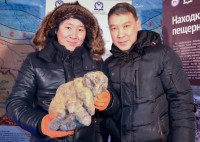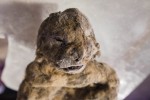 Last summer, two cave lion cubs were found in the permafrost on the bank of the Uyandina River in Yakutia, Siberia. The water levels of the river had risen with the warmth of the summer. When the waters retracted, cracks appeared in the banks. Yakov Androsov, a contractor with the Academy of Sciences of the Republic of Sakha (Yakutia) who was in the area collecting mammoth tusks, spied some ice with something inside it in one of the cracks. Upon closer inspection, he recognized the remains of prehistoric felines in the ice. He quickly placed them in a glacier to preserve them.
Last summer, two cave lion cubs were found in the permafrost on the bank of the Uyandina River in Yakutia, Siberia. The water levels of the river had risen with the warmth of the summer. When the waters retracted, cracks appeared in the banks. Yakov Androsov, a contractor with the Academy of Sciences of the Republic of Sakha (Yakutia) who was in the area collecting mammoth tusks, spied some ice with something inside it in one of the cracks. Upon closer inspection, he recognized the remains of prehistoric felines in the ice. He quickly placed them in a glacier to preserve them.
 When the remains were recovered and examined by experts from the Academy of Sciences, they were identified as two very young Pleistocene cave lion cubs in exceptional condition. The cubs have been named Uyan and Dina after the river where they were found. Both are almost complete, Uyan more so than Dina, with body parts intact. Fur, legs, ears, eyes, tails, soft tissue, even their whiskers were preserved by the deep freeze. The lions were very young when they died, no more than two weeks old. Their eyes weren’t open and all of their baby teeth hadn’t grown in yet. They are about the size of plump house cats.
When the remains were recovered and examined by experts from the Academy of Sciences, they were identified as two very young Pleistocene cave lion cubs in exceptional condition. The cubs have been named Uyan and Dina after the river where they were found. Both are almost complete, Uyan more so than Dina, with body parts intact. Fur, legs, ears, eyes, tails, soft tissue, even their whiskers were preserved by the deep freeze. The lions were very young when they died, no more than two weeks old. Their eyes weren’t open and all of their baby teeth hadn’t grown in yet. They are about the size of plump house cats.
 These are by far the most complete remains of cave lions ever found. Worldwide, only bones, partial skeletons and carcass fragments of cave lions have been found before this discovery. In Yakutia, it was only a few skulls, teeth and individual bones. Those limited remains and Stone Age cave art were the sole sources of information scientists had what cave lions looked like. The preservation of the cubs will answer a great many questions about the species.
These are by far the most complete remains of cave lions ever found. Worldwide, only bones, partial skeletons and carcass fragments of cave lions have been found before this discovery. In Yakutia, it was only a few skulls, teeth and individual bones. Those limited remains and Stone Age cave art were the sole sources of information scientists had what cave lions looked like. The preservation of the cubs will answer a great many questions about the species.
Scientist Dr Gennady Boeskorov said: “The main complexity of our task is that here we have not adult lions, but cubs, so we are searching for the specialists experienced in the research of cubs. It’s interesting to see the adaptive mechanisms, which helped them to survive in the cold. They definitely differed from the modern lions, and we think there should be something that allowed them to adapt to the climate.”
Dr Protopopov said: “We suppose that the cave lioness behaved like the modern lioness in pride,” he said. “It seems like she gave birth to the cubs and hid them in cave or hole to protect from the hungry lion. Then the landslide covered it and they remained surrounded in permafrost. Also the air intake was blocked, and this helped their preservation.”
 Cave lions went extinct about 10,000 years ago, so the cubs are at least that old. The remains will be radiocarbon tested for a more precise date range. Scientists from all over the world will contribute to the study of these little guys in the hope we can learn more about how they lived and died, their familial relations and what they ate.
Cave lions went extinct about 10,000 years ago, so the cubs are at least that old. The remains will be radiocarbon tested for a more precise date range. Scientists from all over the world will contribute to the study of these little guys in the hope we can learn more about how they lived and died, their familial relations and what they ate.
Earlier this month, Dina, the less preserved of the cubs, was partially thawed and had samples taken at the Mammoth Museum in Yakutsk so tissues could be studied under the microscope. Also present was controversial South Korean cloning expert Professor Woo Hwang Sok who wanted samples of his own for a potential cave lion cloning project. He’s taken mammoth samples before, but there is a big difference between a mammoth carcass and a lion cub and the Yakutian Academy of Sciences refused to let him take a piece of the cub large enough to satisfy him.
The Korean professor wanted a large section, such as part of the skull or a leg but this was opposed by the local experts who are anyway withholding one of the cubs from any research – the better preserved of the pair, called Uyan – confident that more advanced techniques in future years will ensure more is gleaned from it than if research is done now.
[Dr. Protopopov] revealed: “The dispute arose from the fact that the researchers, as always, want to be completely sure and take more tissue, and I can understand them. But the lion is not fully preserved and there are not so many tissues. We have planned other studies, so it is important to preserve the original morphology of the remains. Such disputes are normal in all studies, and in the end we came to a compromise.”
Director of the Mammoth Museum Semyon Grigoriev defended the decision to limit the sample available to the cloning guru. “The Koreans are sceptical and unhappy with the samples,” he said. “They expected to take more, as they did with the mammoth previously. But it will not work with these little kittens.”
Besides, I have yet to see any results from these ancient cloning studies. The institute Woo Hwang Sok leads, Sooam Biotech Research Foundation, does have a lot of material on its website about cloning your dead dog, though.